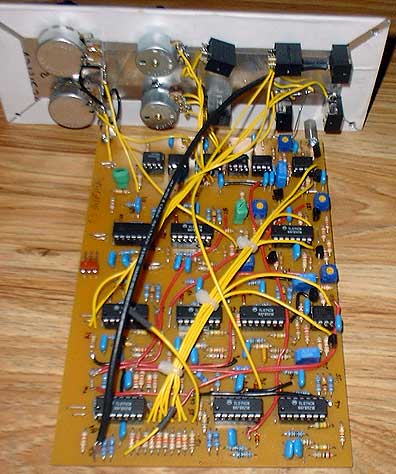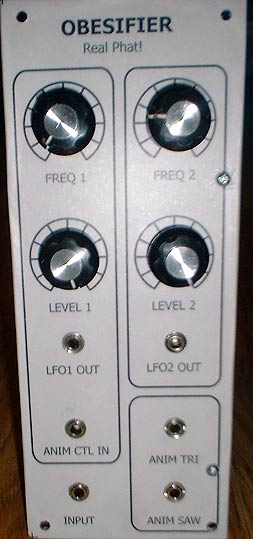I call it the "Obesifier" because it makes your synth sound real phat!
This is another variation of the Multi Phase Waveform Animator circuit from Electronotes #87, by Bernie Hutchins, incorporating additional design ideas from EN #108 by Lester Ludwig.
Each of the 8 modulation stages produces a sort of PWM effect (actually Symmetrisized Ramp Modulation) on sloped input waveforms (saw, triangle, sine). The outputs of each of the stages are then summed. Since there are eight different modulation frequencies, the sound is much richer than PWM. You get the lush beating sound like three VCO's in parallel, but it only requires one VCO to drive the module. It's also very interesting to look at on a scope.
Features
- Saw, Tri, or Sine input
- 8 independent modulation stages, six with fixed frequencies, two controlled by adjustable on board LFO's
- One of the modulation LFO's can be overridden by an "Animator Control Input". This allows you to control the modulation of one stage with an external VCO, where you can use one that tracks the input signal VCO.
- On board LFO's have adjustable frequency and level, and triangle outputs are brought to front panel so they can be used for other purposes
- Two output types: Animated "Saw" and animated Triangle
The animated triangle output has a mellower, more subtle sound than the animated "Saw". Listen to the sound samples.
| Status |
Obesifier Waveform Animator schematic
Sound samples
A bit of clipping on some of these, but they still sound pretty good.- Drone, Saw input, animated saw output
- Drone, Tri input, animated saw output
- Short tune, with a touch of reverb added
- S/H, tri input, saw output, into BP filter, manually swept corner freq
- Tri input, animated tri output. Messing with one of the LFO frequencies toward the end
- Another tune, Tri-Tri using external VCO input for animation control
Tips for use:
- Input waveform should be approximately +/-5v amplitude saw, tri, or sine
- Even with no input, you get popping sounds as each of the modulations stages reset. So make sure you put your VCA after the Obesifier in the chain. The best way to use it is to think of it as an extension of a VCO.
- Sounds best with low frequency drones


